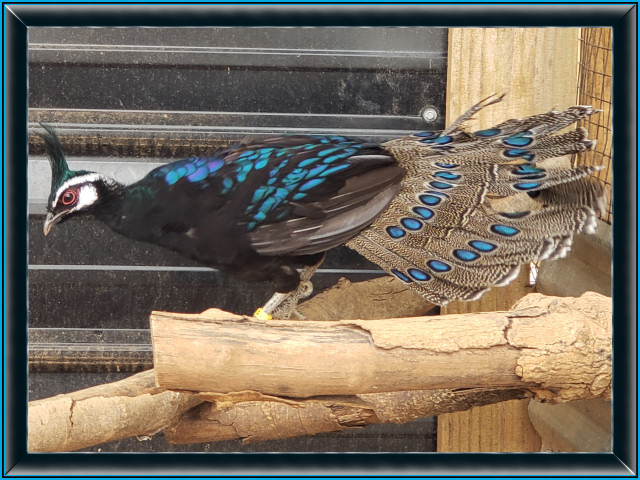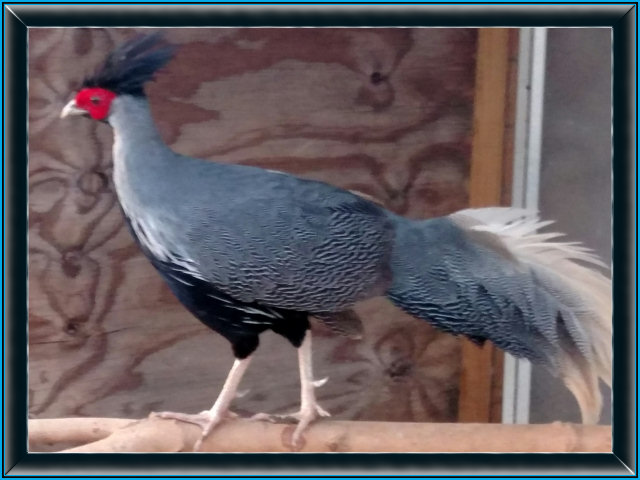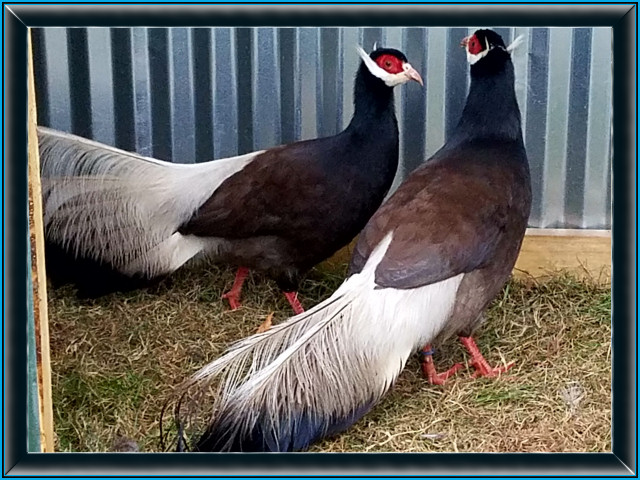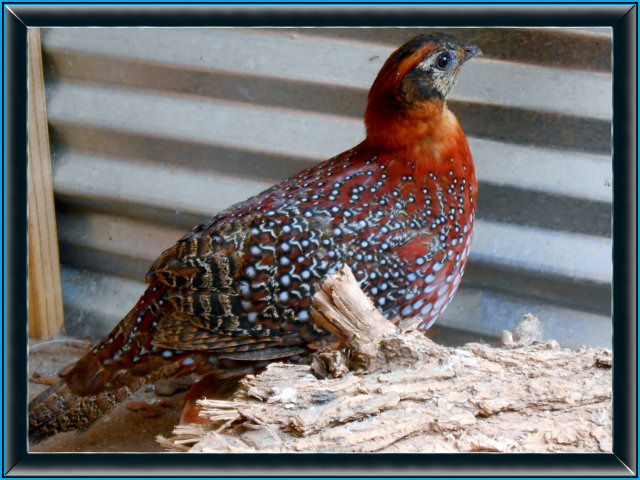
Great Argus Pheasant
(Argusianus argus)
Click the image to view additional pictures
| Common Name: | Great Argus Pheasant |
| Scientific Name: | Argusianus argus |
| Clutch Size: | 2 to 4 eggs |
| Incubation Period: | 30 days |
| Habitation: | This pheasant's natural habitat can be found in the jungles of Borneo, Sumatra and Malay Peninsula in Southeast Asia, where it can be seen feeding on the forest floors in the early mornings and evenings |
| Conservation Status: | Listed as a CITES II, a near-threatened species, the primary threat to survival is habitat destruction and hunting in some areas |
Lineated Kalij Pheasant
(Lophura leucomelanos lineata)
Click the image to view additional pictures
| Common Name: | Lineated Kalij Pheasant |
| Scientific Name: | Lophura leucomelanos lineata |
| Clutch Size: | 6 to 9 eggs |
| Incubation Period: | 22 to 23 days |
| Habitation: | Varied; from mountainous forests to lowland cultivated lands and forests, depending on race |
| Conservation Status: | Lineated Kalij are fairly well represented. |
Palawan Peacock-Pheasant
(Polyplectron napoleonis)

| Common Name: | Palawan Peacock- Pheasant |
| Scientific Name: | Polyplectron napoleonis |
| Clutch Size: | 2 eggs |
| Incubation Period: | 19 to 21 days |
| Habitation: | Endemic to the Philippines, the Palawan peacock-pheasant is found in the humid forests of Palawan Island in the southern part of the Philippine archipelago |
| Conservation Status: | Due to ongoing habitat loss, small population size and limited range as well as hunting and capture for trade, the Palawan peacock-pheasant is classified as Vulnerable in the IUCN Red List of Threatened Species. It is listed on Appendix I of CITES |
Grey Peacock Pheasant
(Polyplectron bicalcaratum)
Click the image to view additional pictures
| Common Name: | Grey Peacock Pheasant |
| Scientific Name: | Polyplectron bicalcaratum |
| Clutch Size: | 2 eggs |
| Incubation Period: | 21 days |
| Habitation: | The tropical forests of south-east Asia |
| Conservation Status: | Well established; the most commonly seen of the genus in captivity |
Brown Eared Pheasant
(Crossoptilon mantchuricum)
Click the image to view additional pictures
| Common Name: | Brown Eared Pheasant |
| Scientific Name: | Crossoptilon mantchuricum |
| Clutch Size: | 5 to 8 eggs |
| Incubation Period: | 26 to 27 days |
| Habitation: | Northeastern China |
| Conservation Status: | Endangered. Brown Eared are fairly common in aviculture and recent importations should help the American captive gene pool. |
Koklass Pheasant
(Pucrasia macrolopha)
Click the image to view additional pictures
| Common Name: | Koklass Pheasant |
| Scientific Name: | Pucrasia macrolopha |
| Clutch Size: | 9 to 12 eggs |
| Incubation Period: | 26 to 27 days |
| Habitation: | The koklass pheasant is confined to high altitude forests from Afghanistan to central Nepal, and in northeastern Tibet to northern and eastern China. Like the western tragopan, it does not extend its range above the tree line. |
| Conservation Status: | Least concern |
Szechuan White Eared Pheasant
(Crossoptilon crossoptilon crossoptilon)
Click the image to view additional pictures
| Common Name: | White Eared Pheasant |
| Scientific Name: | Crossoptilon crossoptilon crossoptilon |
| Clutch Size: | 4 to 7 eggs |
| Incubation Period: | 24 to 25 days |
| Habitation: | China, from southeastern Tibet and western Szechuan, southern Qinghai, northwestern Yunnan |
| Conservation Status: | Vulnerable, habitat loss and hunting has taken toll in many areas of range |
Drouynii White Eared Pheasant
(Crossoptilon crossoptilon)
Click the image to view additional pictures
| Common Name: | White Eared Pheasant |
| Scientific Name: | Crossoptilon crossoptilon |
| Clutch Size: | 4 to 7 eggs |
| Incubation Period: | 24 to 25 days |
| Habitation: | China, from southeastern Tibet and western Szechuan, southern Qinghai, northwestern Yunnan |
| Conservation Status: | Vulnerable, habitat loss and hunting has taken toll in many areas of range |
Temminck's Tragopan Pheasant
(Tragopan temminckii)
Click the image to view additional pictures
| Common Name: | Temminck's Tragopan Pheasant |
| Scientific Name: | Tragopan temminckii |
| Clutch Size: | 3 to 6 eggs |
| Incubation Period: | 28 days |
| Habitation: | The most widespread of the genus, this Tragopan is found in northeastern India through Myanmar (Burma) to northern Vietnam north to central China |
| Conservation Status: | Well established; the most commonly seen of the genus in captivity |
Cabot Tragopan Pheasant
(Tragopan caboti)
Click the image to view additional pictures
| Common Name: | Cabot Tragopan Pheasant |
| Scientific Name: | Tragopan caboti |
| Clutch Size: | 2 to 4 eggs |
| Incubation Period: | 28 days |
| Habitation: | Resident in Zhejiang, Jiangxi, Hunan, Guangdong, Guangxi and Fujian |
| Conservation Status: | Endangered |
Malayan Peacock-Pheasant
(Polyplectron malacense)

| Common Name: | Malayan Peacock-Pheasant |
| Scientific Name: | Polyplectron malacense |
| Clutch Size: | One of the few pheasants known with certainty to have a one-egg clutch. |
| Incubation Period: | 22 to 23 days |
| Habitation: | Endemic to lowland forests of the Malay Peninsula from the Isthmus of Kra region southwards. |
| Conservation Status: | Vulnerable (IUCN 3.1) |
Copyright Enchanted Birds - All Rights Reserved
Google+









